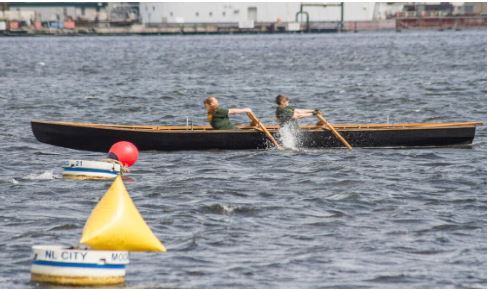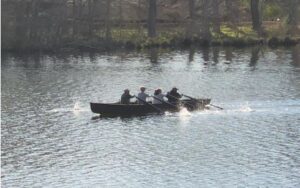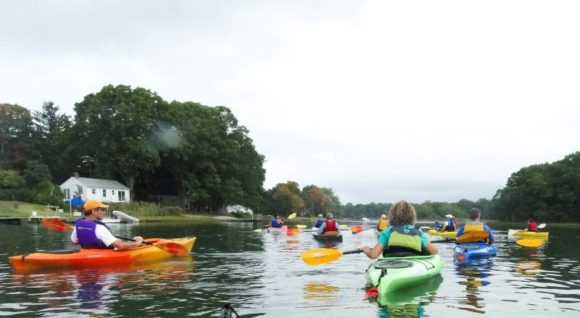
Learn to row an Irish currach on Saturday, Oct. 15, at Hains Park in Old Lyme.
OLD LYME — Learn to row Irish … remember, you don’t need to be Irish to row Irish!
Readers are invited to try out the ancient art of Irish Currach Rowing, Saturday, Oct. 15, at Hain’s Park, Rte. 1/Boston Post Rd. in Old Lyme from 9 a.m. to 1 p.m.
Send an email to reserve your time: 9:00, 9:30, 10:00, 10:30, 11:00, 11:30 a.m., 12:00 or 12:30 p.m. to [email protected]
An Irish currach is a traditional vessel made of wood lathe and covered in canvas. Currachs date back several thousand years. They were used for trade among islands, between islands and mainland and along coastal mainland villages. The relatively light (for their size) fishing/trade boats, which could withstand high swells, have been streamlined in design for rowing competitions.
Veteran and newcomer rowers are all welcome. Pre-register before Oct. 15. You will be required to sign a waiver.
Request the forms from [email protected]. Pre-register and also take an introductory lesson to receive a free team t-shirt.
 The organizers suggest that attendees should bring gloves.
The organizers suggest that attendees should bring gloves.
There is no obligation to join the group — simply come and try out currach rowing.
For more information, contact [email protected]
This event is sponsored by New London Currach Rowers with support from the Ancient Order of Hibernians of New London County and the Irish Coastal Club, the New London Maritime Society/New London Custom House and Forty Thieves Irish Pub.
The dramatic amount of large plastic material that has been introduced into our rivers, bays and oceans has been well documented, and the harm this material can cause to marine organisms is well known to conservationists. Billions of pounds of plastic have been found in about 40 percent of the world’s oceans, an amount that could outweigh all the fish in the sea by 2050.
This pollution has a direct and deadly effect on wildlife. Thousands of marine mammals such as seabirds, seals and sea turtles are killed each year after ingesting plastic or getting entangled in it. Moreover, these macro-plastics also fragment into micro-plastic particles via weathering and UV degradation. According to one report, over 99 percent of plastic that entered the ocean since 1950 has sunk below the first few hundred feet of the ocean. There are 10,000 times more microplastics on the seafloor than in the polluted surface waters.
These small particles can also interact with marine animals, especially those that filter feed. The uptake and accumulation of microplastics by filter-feeding, bottom-dwelling animals such as bivalves, is not clear. Equally unclear is whether ingestion of microplastics by filter feeders results in toxicological effects. This is the focus of Dr. Ward’s research.
In his presentation, Dr. Ward will discuss the current understanding of plastic pollution in the ocean and its interactions with marine animals. He will present his research into the capture, ingestion, rejection and elimination of microplastics by commercially important bivalves. The goal of this work is to understand uptake of microplastics by marine animals, identify a robust bioindicator for plastic particles in the ocean, and examine the potential for transfer of microplastics through the food chain.
The free program will be interactive with an opportunity for participants to ask questions. There is no charge, but space is limited and registration is required. To register, visit https://www.ctaudubon.
Professor and Head, Department of Marine Sciences, UConnDr. Ward is an experimental biologist whose research interests are directed toward an understanding of the dynamic interactions between marine animals and their environment. Using an integrative approach, he directs his students in the study of processes ranging from the organism to the ecosystem level.
He is particularly interested in the behavior and physiology of benthic, particle-feeding invertebrates. Much of his research focuses on commercially important bivalves (e.g., clams, mussels, oysters), which are key components of most coastal ecosystems. These animals provide vital ecosystem services and are an important link between oceans and human health.
About the Roger Tory Peterson Estuary Center:
Named for the renowned artist, scientific illustrator, environmental educator, and conservation advocate, Connecticut Audubon Society’s Roger Tory Peterson Estuary Center is known for its work in environmental education, conservation, research, and advocacy. The center is dedicated to facilitating scientific research, establishing high-quality environmental education for children, teens and adults, and promoting outreach and advocacy to preserve, protect and conserve the estuary and its beauty for generations. From it’s 5.25-acre site on the Lieutenant River in Old Lyme, the Center serves young people and adults across the region in person and virtually, offering small group programs like bird walks and owl prowls, a CT River ecological expeditions course, citizen scientist activities, vacation and summer camp programs and a curriculum-based Science in Nature program for schools in Southeastern Connecticut.
LYME — The Lyme Board of Selectmen will host the Annual Town Budget meeting on Thursday, May 25, at 6 p.m. at the Lyme Town Hall, 480 Hamburg Rd., Lyme, at 6 p.m. The board will present the following agenda:
- Acknowledge receipt of the Town of Lyme Annual report for the Fiscal Year ending June 30, 2022.
- Consider and act on estimates and recommendations of the Board of Finance for the Fiscal Year ending June 30, 2024.
If any votes are taken, electors and citizens eligible to vote in a Town Meeting will be able to vote.
The Town of Lyme has published a summary of the budget for the year ending June 30, 2024. To view and/or download the budget summary, visit this link.
OLD LYME — The Old Lyme Land Trust (OLLT) Regatta will be held on Saturday, Sept. 9, at 1 p.m. It will be a two to two and a half hour excursion. The OLLT guide, Fred Fenton, is an experienced kayaker, who has led many of the Trust’s past regattas. Paddlers of all ages are welcome.
A US Coast Guard-approved life jacket or vest is required. Bring your own kayak (or canoe or stand-up paddleboard).
Space is limited and pre-registration is required.

Contact [email protected] with name(s), number of boats, number of cars, and contact information. More details will be provided upon confirmation.
The event is free.
Donations to support OLLT’s work are appreciated and can be made via the OLLT website or by mail to the OLLT at P.O. Box 163, Old Lyme, CT 06371.